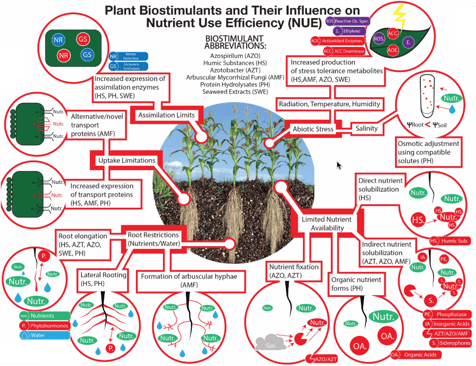The Science Behind Biostimulants: What Do We Really Know?
by Douglas Amaral @ University of California Cooperative Extension


Biostimulants are a category of agricultural inputs designed to improve plant growth, yield, and stress tolerance through mechanisms that do not rely on supplying nutrients directly. Unlike traditional fertilizers, biostimulants act by stimulating natural biological processes in plants and soil. Common plant stimulants include seaweed extracts, humic and fulvic acids, amino acids, microbial inoculants, and protein hydrolysates. Their increasing use is driven by the demand for more sustainable, environmentally responsible farming practices, and increased plant performance.
These products have been shown to enhance nutrient uptake, root and shoot development, flowering, and resilience to abiotic stresses such as drought, salinity, and extreme temperatures. In some farming systems, such as organic and regenerative agriculture, biostimulants are valued for improving soil structure, microbial activity, and long-term fertility without relying on synthetic chemicals. Some studies also suggest that biostimulants can reduce the need for chemical fertilizers and pesticides, potentially lowering costs and environmental impacts.
The Biostimulant Controversy
Despite the potential benefits, biostimulants remain a controversial topic due to inconsistent regulation, limited scientific validation, and questionable marketing practices. One core issue is the absence of a unified global definition and regulatory framework. For example, the European Union’s 2019 Fertilizing Products Regulation (EU) 2019/1009 provides a formal definition and sets quality and efficacy standards. In contrast, countries like the United States and Brazil lack cohesive guidelines, often lumping biostimulants into broad categories like plant growth regulators or soil amendments. This regulatory inconsistency contributes to confusion among growers and limits oversight of product claims.
Biostimulants have attracted growing attention since they offer the potential to enhance yields through stimulating natural processes in crops. Source: Biostimulants for sustainable crop production, 2020. Editors: Rouphael, Y.; du Jardin, P; Brown, P.; De Pascale, S.; Colla, G. Illustration: Sisniegas, C.; Park, M.; and Schmidt, J.
From a scientific standpoint, the performance of biostimulants is mixed. While certain formulations have demonstrated measurable benefits in controlled experiments, many others lack peer-reviewed validation or consistent field data. This variability is due in part to the diverse nature of biostimulant ingredients and their complex interactions with soil ecosystems and plant physiology. Many products are marketed with exaggerated or unproven claims, undermining confidence among farmers, agronomists, and researchers.
Quality control is another concern. Because many biostimulants are derived from natural sources, their composition can vary significantly between batches, affecting consistency and performance. In the absence of standardized efficacy testing or certification protocols, growers often have limited information to assess product reliability or return on investment.
Furthermore, while biostimulants are marketed as cutting-edge, sustainable solutions, some growers remain skeptical. Compared to fertilizers and pesticides, which undergo rigorous testing and are supported by decades of data, biostimulants often reach the market without robust evidence or clear usage guidelines. In such cases, the cost of application may outweigh the benefits, especially when expected outcomes are vague or inconsistent.
Fertilizer in Disguise? The Risk of Misleading Marketing
Some companies are taking advantage of the growing demand for biostimulants by falsely marketing traditional fertilizers as biostimulants. This practice misleads farmers and exploits regulatory loopholes. By using vague language like “natural growth enhancer” or “plant growth booster,” these companies often avoid disclosing the full nutrient content of their products. As a result, they charge a premium for what may be little more than a diluted or reformulated fertilizer.
This tactic not only deceives growers but also undermines trust in the biostimulant industry as a whole. Products that are marketed as innovative, environmentally friendly solutions may, in fact, provide no additional benefit beyond what conventional fertilizers already offer, if any. Without transparency and enforceable standards, growers risk investing in inputs that offer little value, and legitimate producers face unfair competition from misleading brands.
The Path Forward: Science, Standards, and Trust
More rigorous scientific research is urgently needed to clarify how biostimulants work, which products are truly effective, and under what conditions they deliver value. The biological mechanisms involved (interactions between plants, microbes, and soil) are complex and highly context-dependent. A product that works in one crop or environment may not perform the same in another. Reproducible field trials, standardized testing protocols, and clearer product labeling are essential to distinguish effective biostimulants from those driven purely by marketing.
For now, biostimulants hold significant promise as tools for enhancing plant performance and soil health with minimal environmental impact. However, their potential is undermined by regulatory gaps, inconsistent scientific validation, and misleading commercial practices. With stronger oversight, clearer definitions, and more rigorous science, biostimulants can become a valuable part of the agricultural toolbox. Until then, growers should approach these products with a critical eye, seeking out evidence-backed formulations and demanding transparency from manufacturers.
